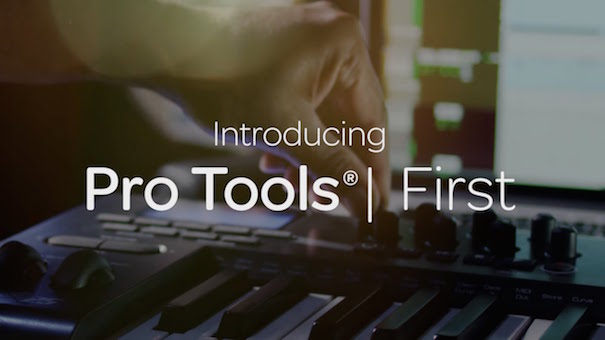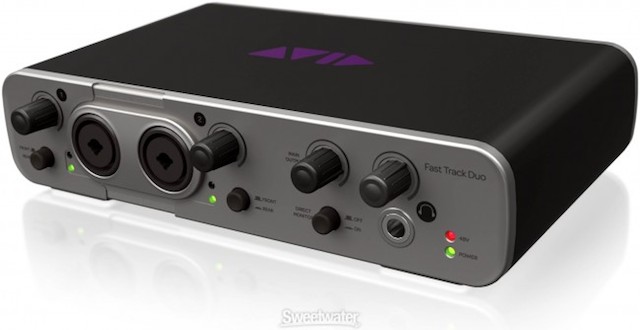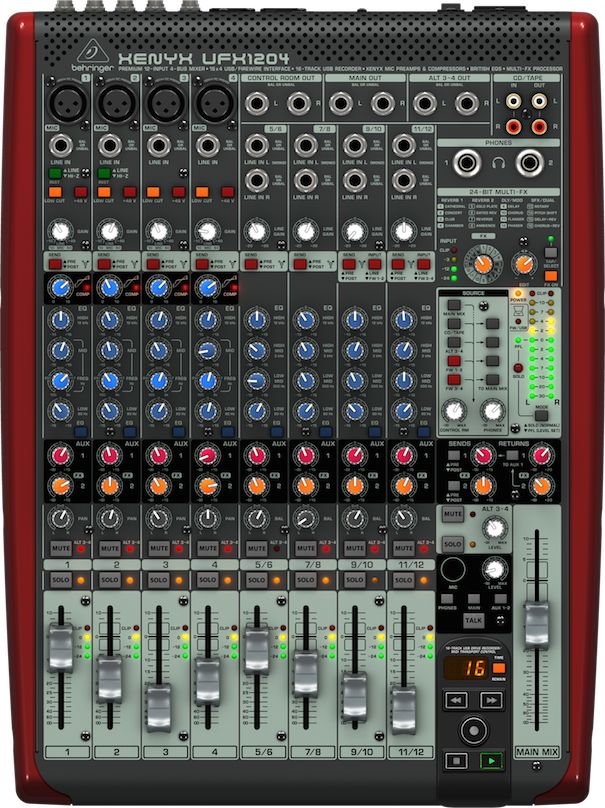Back in February, I published an article called: 48 reasons why GarageBand is kryptonite for video production. At that point, I didn’t even know that Avid had announced Pro Tools First, a free yet extremely powerful version of their popular software. In fact, I didn’t find out about it until NAB in April. This article explores Pro Tools First’s capabilities, and who should use it (beyond Avid’s limited target) despite how confusing its name is when pronounced in a sentence in English.

Back in February, I published an article called: 48 reasons why GarageBand is kryptonite for video production. At that point, I didn’t even know that Avid had announced Pro Tools First, a free yet extremely powerful version of their popular software. In fact, I didn’t find out about it until NAB in April. This article explores Pro Tools First’s capabilities, and who should use it (beyond Avid’s limited target) despite how confusing its name is when pronounced in a sentence in English.
In this article
- Beyond Avid’s target for Pro Tools First
- What Pro Tools First offers as a free audio editor
- Light years ahead of GarageBand
- Hardware support
- Use a preamp/A-to-D converter or a digital mic?
- How does Pro Tools First deal with plugins?
- Pro Tools First’s exporting capability
- The potential gotcha
- Who may want to use Pro Tools First
Beyond Avid’s target for Pro Tools First
If you read Avid’s promotional materials or see the following video, you’ll quickly realize that Avid is targeting aspiring musicians with its Pro Tools First.
However, there are many more segments of users that would be interested in a free audio editor that supports up to 16 tracks of 48 kHz/24-bit audio (or actually even beyond that, as you’ll read a little ahead), and accepts up to 4 simultaneous input sources.
This article isn’t about how the free —or freemium— Pro Tools First product might affect current users of the paid Pro Tools or Pro Tools HD. It’s about how it affects and compares with the pre-existing audio editing applications, from free up to US$200.
What Pro Tools First offers as a free audio editor
Light years ahead of GarageBand

If you read my recent article called 48 reasons why GarageBand is kryptonite for video production, you’ll know that the free GarageBand from Apple lacks 48 kHz, which is the absolute standard for digital audio for digital video. That’s why I have declared GarageBand a waste of anybody’s learning time investment, even if they initially won’t be producing any audio for video.
Fortunately, the free Pro Tools First indeed does support 48 kHz. Beyond that video standard, Pro Tools First can aim low by supporting 44.1 kHz/16-bit for 1980s-ish projects still destined to the waining compact disk (CD) and —in the short term— audiobooks (although I expect audiobooks to be upgraded to 48 kHz soon). If you really need it, Pro Tools First can even aim even higher to 96 kHz/32-bit, but that capability depends on your connected hardware.
Anybody who thought that s/he could make fun of Pro Tools First’s audio quality —or video sampling rate compatibility— may now very quietly leave the room, maintaining Pro Tools First’s potential noise floor of zero dB 
Hardware support
Apparently, Pro Tools First is based on the professional version of Pro Tools 12, since on the Mac, Pro Tools First already officially supports up to Yosemite 10.10.2, while the professional version of Pro Tools 11 only is officially supported up until Yosemite 10.10.1. If you have an older Mac, Pro Tools First can function as far back as 10.9.5. On the Mac, Avid recommends the following hardware:
- Intel Core 2 Duo processor or better
- 2GB RAM (4GB or more recommended)
- Minimum 1280 horizontal monitor resolution
- Internet connection for installation
- 15GB disk space for installation
- USB-port, FireWire-port or Thunderbolt-port for Core Audio-supported audio device (Yes, Pro Tools First works with any Core Audio device!)
- Supports Marketplace in-app purchased AAX plug-ins in Pro Tools First
- PACE hard disk authorization (No iLok required, Yeah!)
For Windows, Avid recommends:
- Intel PC with Windows 7 64-bit (Home Premium, Professional and Ultimate Editions) or Windows 8/8.1 (Standard and Pro Editions)
- Intel Core 2 Duo processor or better
- 2GB RAM (4GB or more recommended)
- Minimum 1280 Horizontal Monitor Resolution
- Internet connection for installation
- 15GB disk space for installation
- USB-port or FireWire-port for ASIO-supported audio device
- Supports Marketplace in-app purchased AAX plug-ins in Pro Tools First
- PACE hard disk authorization (no iLok required) (No iLok required, Yeah!)
I love the fact that no iLok is required with Pro Tools First, for the same reason that I chose not to use any DRM in my ebooks. 
See my To DRM or not to DRM? That is the question for today’s digital content producers from 2011 for my philosophy on Digital Rights Management and piracy.)
I also love that (on the Mac) Pro Tools First works with any Core Audio device, so if you choose to record, edit, and monitor with Pro Tools First, you are completely free to use any brand of Core Audio device (i.e. digital microphone or A-to-D converter). You are not locked into using Avid hardware.

Having said that, I must applaud the quality, stability, cleanliness, latency-free monitoring, and cost-effectiveness of Avid’s FastTrack Duo (shown above), which I covered in this article back in January 2015. The FastTrack Duo currently has a street price of US$189.99 as of the publication time of this article. For those readers who may be leaning towards purchasing the professional version of Pro Tools 12 at some point, rather than Pro Tools First, the included license of Pro Tools Express will earn you a very low US$199 upgrade price (rather than paying US$899), but don’t bother installing the Express version! You’ll just need the Express license handy when activating the professional Pro Tools 12 upgrade license. If you mistakenly install the Express, you will later have to invest about 30 minutes of surgical removal before installing the Pro version. I know, because I recently had to help a friend who fell into that trap. The FastTrack Duo is also Core Audio compliant and therefore works with several other audio and video applications for Mac, including other apps I am evaluating for future review. And as mentioned in that January article, the FastTrack Duo is also iOS compliant for use with your iPad/iPhone/iPod Touch using the appropriate cable, as I described in that article.
Use a preamp/A-to-D converter or a digital mic?
If you are wondering when it makes more sense to use a preamp/A-to-D (analog-to-digital) converter like Avid’s FastTrack Duo, the iRig Pro from IK Multimedia (which I reviewed here), some other one… or to use a high-quality digital USB mic instead, this paragraph will clarify that for you. If you already own some very high-end analog microphone and would like to continue to use it, you are better off by purchasing one of the preamp/A-to-D converters. Between Avid’s FastTrack Duo preamp/A-to-D converter and the iRig Pro from IK Multimedia, recall that the from IK Multimedia accepts only a single XLR source at a time, and does not offer onboard latency-free monitoring, which is vital if you want to hear yourself while you narrate or sing. The Avid’s FastTrack Duo preamp/A-to-D converter offers recording from up to two XLR sources at a time, and also offers onboard latency-free monitoring. If you don’t already own a digital mic, you should realize all of the ones I’ve tested from IK Multimedia fortunately offer up to 48 kHz/24-bit, but do not offer onboard zero-latency monitoring. The Apogee Mic is the same: 24-bit, but no onboard zero-latency monitoring. On the other hand, the RØDE NT-USB (which I reviewed in this article) offers latency free monitoring and records up to 48 kHz, but only 16-bit resolution. The same exact thing applies to the Audio Technica AT2005USB when using its own USB output. So if you are going to record with the RØDE NT-USB or with the USB output of the Audio Technica AT2005USB, you should be sure to set your level at nearly perfect when recording, since you’ll have less latitude to change it later without loss, as explained in my recent article Understanding 24-bit vs 16-bit audio production & distribution. So ask yourself: Do I need onboard zero-latency to hear myself while recording? Do I need 24-bit recording? Do I need both? Do I need one, two, or even more simultaneous XLR inputs? If you need more than two simultaneous XLR inputs recorded on independent tracks,
you should consider the Behringer UFX1204 which Ray Ortega of The Podcasters’ Studio reviewed here. Everything I wrote in this paragraph applies to Pro Tools First or to just about any audio or video editor.
How does Pro Tools First deal with plugins?
Over 20 plug-ins are included free with Pro Tools First. The first one may not be so interesting to non-musicians. It’s called Xpand!2. According to Avid, Xpand!2 is a great Virtual Instrument to start creating music. Xpand!2 comes with over 2,500 presets including piano, organ, pads, synths, drums, percussion, brass, woodwind etc. It is part of the Air collection of Virtual Instruments. I haven’t been able to find a complete list of the other 19 free plugins, but Avid has insinuated that they are related to equalization and dynamics.
Regarding other available plugins
Pro Tools First supports AAX Native 64 and AAX AudioSuite 64 plug-ins purchased from within the in-app Store. Avid says that we should check the description/specs in the Avid Marketplace to confirm if an iLok is required. (You know I despise the concept of the iLok.). Plug-in bundles which include First in the name are specifically designed for use with Pro Tools First and fortunately do not require an iLok. Avid says that those plug-ins should download and automatically install, without even needing to re-launch Pro Tools First. Avid also cautions that only plug-ins purchased through the Avid Marketplace with your Avid Master Account will work with Pro Tools First. All other plug-ins will remain hidden and unavailable at launch. If you purchase plug-ins for Pro Tools First and then later upgrade to the professional Pro Tools (if interested, see my FastTrack Duo section above to get an amazing deal), those plug-ins will be available as the AAX Native 64 format in the professional Pro Tools 12.
Finally, Avid explains that many 64-bit AAX plug-ins from Avid and third-party manufacturers do not require an iLok to use and are ideal for use with Pro Tools First, but must be purchased from within Pro Tools First using the in-app purchase feature. You may also choose to purchase and use any AAX Native 64-bit plug-ins from the in-app Avid Marketplace that require an iLok, but you will need to purchase an iLok USB Smart Key separately to allow activation of these plug-ins.
Pro Tools First’s exporting capability
Before exporting, you must bounce all of your potentially multiple tracks to a stereo file. The steps suggested by Avid are to Save, then go to File>Export>Audio mix. At that point, we’ll be presented with a dialog box with several options. The file types include uncompressed WAVE or uncompressed AIFF. It also allows us to check our bit depth (16-bit, 24-bit, and 32-bit floating point) and sampling rate. Then we can select a file name and select the desired folder (directory) to export the file. At the end, there is the option for “Offline Bounce” which means that it will happen faster than in real time, as I covered in my first look at Pro Tools 11 back at NAB 2013.
At least with the initial revision, Pro Tools First offers no compressed export options, like MP3 or AAC (M4A). That is not a deal breaker for me, since there are so many other tools to compress, and if you are going to prepare audio for video editing or upload to SoundCloud, you should leave your audio uncompressed anyway. (Any video editor is best given an uncompressed 48 kHz file, and SoundCloud will automatically create a streamable MP3, and will give you the option to make the original uncompressed file downloadable.)
The potential gotcha
Unlike most audio editing programs [including Adobe Audition (covered by Eric Philpot here and here), Amadeus Pro (which I reviewed here), Apple GarageBand (which I criticized due to its lack of 48 kHz here), Apple Logic, Avid’s professional Pro Tools (covered here), and Hindenburg (which I am intensely evaluating for future articles)], Pro Tools First does not record the project file in your local computer. Instead, Pro Tools First exclusively records your project file to Avid’s cloud, and initially limits you to three active projects. Of course, you have unlimited capability to export WAVE or AIFF files as I covered in the prior section, and you are able to delete any or all of the three projects in order to be able to create more. Avid says that in the near future, it will offer the option to pay for the capability of more active projects. What this basically means is to be able to go back and make changes to projects you have already finished, or having multiple audio editing projects in progress, but not yet finished. (More about that in the next session.)
Availability, and who may want to use Pro Tools First
Avid originally offered Pro Tools First for delivery in the first quarter of 2015. Considering that we are already in the middle of the second quarter and it has not released yet, I would expect it any minute. At that point, there are particular things I want to test in it in order to determine how well it compares with other audio editors from free to US$200. For now, here are my potential uses beyond aspiring musicians who don’t already own an equal or superior audio editor (and can live with three active projects at a time):
- Audiobook producers who yet can’t afford the power of Hindenburg ABC
- Audio clips for non-sync video, i.e. opens, bumpers, and closes (of course, at 48 kHz)
- Audio clips for audio and video podcasts
- Audio podcasters
I have produced many audio podcast episodes to date. So far, I have never had any need to go back and re-edit any older episode. On the other hand, I know that Ray Ortega of The Podcasters’ Studio has done so at least once, when he initially included an offer of a giveaway. After the giveaway was no longer available, Ray re-edited and re-published that episode without including the giveaway offer. I am not sure whether Ray did it by opening the original project or not. However, I know that (if designed to begin and enter with a cut and not a dissolve with other material), such a giveaway could be removed by re-opening the uncompressed WAVE file without any quality loss. Fortunately, there is no limit in Pro Tools First to the number of uncompressed WAVE or AIFF you may export: The only potential limitation would be your own hard drive or SSD, as is in the case with any of the other audio editors I mentioned earlier. As a result, I believe that this would not be a reason for a podcaster not to consider using Pro Tools First, unless the same individual human podcast editor is editing more than three podcast episodes simultaneously, which I find unlikely.
Upcoming articles, reviews, and books
Stand by for upcoming articles, reviews, and books. Sign up to my free mailing list by clicking here.
Si deseas suscribirte a mi lista en castellano, visita aquí. Si prefieres, puedes suscribirte a ambas listas (castellano e inglés).
Books, consulting, articles, seminars & audio programs
Contact Allan Tépper for consulting, or find a full listing of his books, articles and upcoming seminars and webinars at AllanTepper.com. Listen to his CapicúaFM program at CapicúaFM.com in iTunes or Stitcher.
My latest book (paperback + ebook)
My most recent book is available in two languages, and in paperback as well as an ebook. The ebook format is Kindle, but even if you don’t have a Kindle device, you can read Kindle books on many other devices using a free Kindle app. That includes iPad, Android tablets, Mac computers, and Windows computers. Although generally speaking, Kindle books are readable on smartphones like Androids and iPhones, I don’t recommend it for this particular book since it contains both color photos and color comparison charts. The ebook is also DRM-free.
In English:

In English, click here and you will be automatically sent to the closest Amazon book page to you based upon your IP address.
Or request ISBN–10: 1456310232 or ISBN–13: 978–1456310233 in your favorite local bookstore.
En castellano:

En castellano, haz clic aquí para llegar al instante a la página del libro correspondiente a tu zona y moneda en Amazon, según tu dirección IP.
o solicítalo en tu librería preferida con los ISBN–10: 1492783390 ó el ISBN–13: 978–1492783398.
FTC disclosure
No manufacturer is specifically paying Allan Tépper or TecnoTur LLC to write this article or the mentioned books. Some of the other manufacturers listed above have contracted Tépper and/or TecnoTur LLC to carry out consulting and/or translations/localizations/transcreations. Many of the manufacturers listed above have sent Allan Tépper review units. So far, none of the manufacturers listed above is/are sponsors of the TecnoTur programs, although they are welcome to do so, and some are, may be (or may have been) sponsors of ProVideo Coalition magazine. Some links to third parties listed in this article and/or on this web page may indirectly benefit TecnoTur LLC via affiliate programs.
Copyright and use of this article
The articles contained in the TecnoTur channel in ProVideo Coalition magazine are copyright Allan Tépper/TecnoTur LLC, except where otherwise attributed. Unauthorized use is prohibited without prior approval, except for short quotes which link back to this page, which are encouraged!

Filmtools
Filmmakers go-to destination for pre-production, production & post production equipment!
Shop Now














